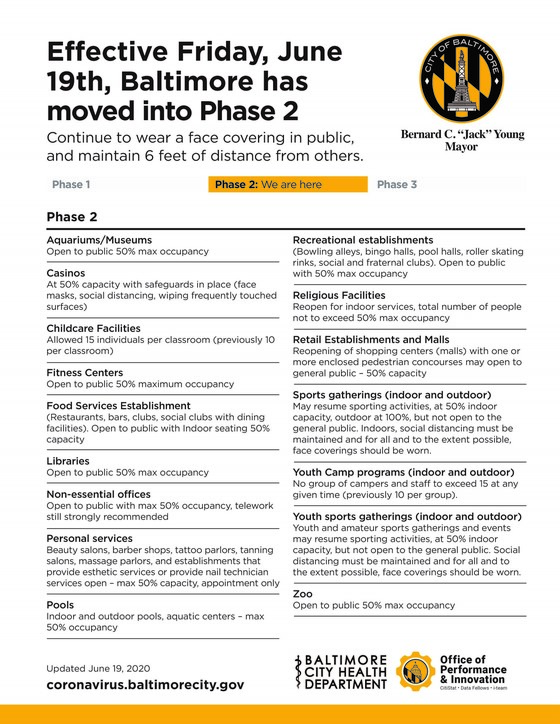|
PRESS RELEASE
Mayor Bernard C. “Jack” Young Announces Baltimore City Will Enter Phase II of Reopening Beginning at 5 p.m. on Friday, June 19
Mayor Young announces loosening of restrictions for restaurants, bars, gyms, cultural institutions, and other establishments
BALTIMORE, MD. — Today, Mayor Bernard C. “Jack” Young announced Baltimore City would move into its second phase of reopening businesses and services. Mayor Young issued the following statement:
“While we continue to work to combat the spread of COVID-19, I am pleased to announce Baltimore City will be shifting into its second phase of reopening businesses and services,” Mayor Young said. “I have been carefully weighing a combination of factors including our health-related data and the economic impacts of continued closures, and I have made the decision to expand reopenings effective at 5 p.m. today.”
The shift into Phase II of reopening allows a number of businesses and services to resume, provided they abide by capacity and safety restrictions:
-
Faith-based entities – facilities are permitted to reopen for indoor services, with the total number of people present not to exceed 50% of the building’s maximum capacity
-
Retail establishments and malls – shopping centers and malls with one or more enclosed pedestrian concourses may open to general public, at up to 50% of maximum capacity.
- Staff are required to wear face coverings while in areas open to the general public and areas in which interaction with other staff is likely, and social distancing should be promoted.
-
Personal services – beauty salons, barber shops, tattoo parlors, tanning salons, massage parlors, and establishments that provide esthetic services or provide nail technician services will be allowed to reopen, at up to 50% of maximum capacity, by appointment only.
- Staff will be required to wear face coverings while in areas open to the general public and areas in which interaction with other staff is likely. Services must be provided on appointment-only basis. After providing services to each customer, staff must clean and disinfect the area in which services were performed in accordance with applicable guidelines from CDC and the Maryland Department of Health (MDH).
-
Recreational establishments – bowling alleys, bingo halls, pool halls, roller skating rinks, and social and fraternal clubs will be allowed to reopen to the public at up to 50% of maximum capacity
-
Food service establishments – restaurants, bars, clubs, and social clubs with dining facilities will be allowed to reopen indoor seating to the public at up to 50% of maximum capacity
- All staff must wear cloth face coverings, no serving of food may be done in a buffet setting, all customers must be seated, and each table must be cleaned and disinfected between seatings in accordance with CDC and MDH guidelines.
-
Fitness centers will be allowed to reopen to the public at up to of 50% maximum occupancy
- All staff must wear cloth face coverings, and sufficient cleaning materials must be provided for patrons to wipe down equipment between each use.
-
Childcare facilities – daycare facilities will be allowed to have up to 15 individuals per classroom
-
Youth camp programs (indoor and outdoor) – indoor and outdoor programs will be allowed to have up to 15 people in a space at any given time, including all staff and campers.
-
Libraries will be allowed to reopen to the public at up to 50% of maximum capacity
-
The Baltimore Zoo, the National Aquarium, and museums will be allowed to reopen to the public at up to 50% of maximum capacity
-
Nonessential offices – nonessential offices will be allowed to reopen to the public at up to 50% of maximum capacity; telework still strongly recommended
-
Pools – indoor and outdoor pools and aquatic centers will be allowed to reopen at up to 50% of maximum capacity.
- Operators must determine the maximum number of people in a pool at any given time by dividing the square footage surface area of the pool (determined by multiplying the length of the pool by the width) by 36. This ensures 6 feet of separation between pool patrons in the water. The maximum number allowed in the pool shall be posted at the pool.
- Pools must follow applicable MDH guidance.
-
Sports activities (indoor and outdoor) – Sports activities will be allowed to reopen at up to 50% of maximum indoor capacity for participants, and outdoors at up to 100% of maximum capacity for participants. Activities will not be open to spectators. If the activity takes places indoors, social distancing must be maintained and face coverings should be worn to the greatest extent possible.
-
Youth sports gatherings (indoor and outdoor) – Youth and amateur sports gatherings and events may resume sporting activities, at up to 50% of maximum indoor capacity, but not open to the general public. Social distancing must be maintained and to the extent possible, face coverings should be worn.
-
Casinos – casinos may reopen at up to 50% capacity, with appropriate safeguards in place.
In addition to the restrictions noted above, businesses proceeding with reopening should plan to:
- Frequently clean high-touchpoint areas (door handles, restrooms) in between patrons.
- Perform temperature checks for every employee.
- Implement policies around staff returning home if ill.
- Implement temperature checks for all patrons entering premises if possible is also advised.
“I want to thank all of our business owners for their patience throughout this process,” Mayor Young said. “While our public health data shows promise, I want to be clear – loosening restrictions does not mean that these activities are risk-free. Residents should continue wearing face coverings, practicing social distancing and other mitigation efforts.”

|